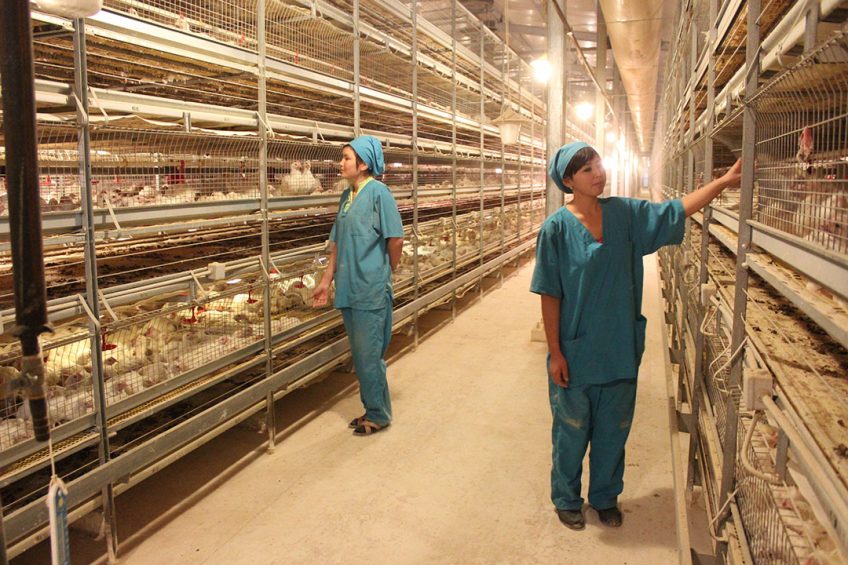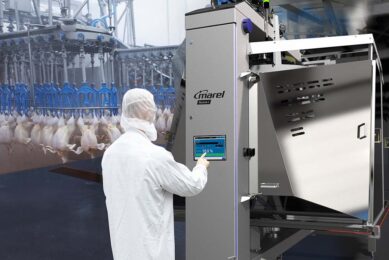Kazakhstan’s poultry undergoing strong production growth

Kazakhstan aims to boost the domestic poultry meat production fourfold by 2027, as compared to the current level to 740,000 tonnes per year. Ruslan Sharipov, chairman of the Union of Poultry Breeders of Kazakhstan sees his country becoming the biggest poultry exporter in Central Asia.
The poultry industry in Kazakhstan is experiencing a strong production growth, Mr Sharipov said. In 2018 the domestic production is expected to reach 230,000 tonnes, which is 50,000 tonnes up as compared to 2017 and 80,000 up as compared to 2016. In 2019, production is expected to significantly grow as the recently launched Makinskaya poultry complex – the biggest poultry farm in Central Asia with the designed production capacity of 50,000 tonnes per year – is slated to start operating in full force.
Poultry meat production tripled
Poultry meat production in Kazakhstan has nearly tripled over the past decade and the local farmers are ready to replicate their success in the coming years. Main export markets are neighbouring countries Tajikistan, Turkmenistan and Kyrgyzstan. Others are China and the Gulf countries. To reach the set target, the industry will need the current state support to continue.
State assistance in broiler and layer production
During the past few years, the government was spending on average KZT18 billion ($ 50 million) per year to encourage investment activity both in broiler meat and egg production in the country. Kazakhstan farmers produced 5.2 billion eggs in 2017 and fully met the domestic demand. As a consequence the government plans to abandon subsidies to the egg industry in 2019, but state aid will still be provided to the broiler farms.
“The government allocates direct subsidies to existing producers, plus the reimbursement of the capital costs to the new ones, when they are building new farms. We urge the government to expand state support by establishing the National Forage Fund, from which poultry farmers could buy feed grains at guaranteed prices. This would reduce risks of price volatility on the domestic grain market,” Mr Sharipov said.
Taking down the US importers
Kazakhstan farmers are prepared to battle against the Russian and the US poultry meat suppliers. In 2017, the country imported 172,000 tonnes of broiler meat, including 140,000 tonnes of frozen poultry from the US. The local companies call poultry from the US “the Bush legs” which is a prevailing term in the post-Soviet states that denotes chicken leg quarters from North America. Local poultry farmers believe these products have extremely poor quality. “We have to compete on our domestic market with imported poultry injected with water and phosphates. This is a widely-used practice aimed to increase the total weight of the broiler cuts, and hence to sell it with better margins on the market,” Mr Sharipov explained.

Imported poultry: Revise the current standard on water content
The Union of Poultry Breeders of Kazakhstan has filed an appeal to the national government, requesting that the current standards on moisture content in imported poultry products be revised, as well as to restrict importing broiler meat with phosphate content. This proposal has already been supported by the Agricultural Minister of Kazakhstan Umirzak Shukeyev. If approved, it would not only protect the domestic market from “the unfair competition,” but also would protect the citizens in the country from the products with rather poor quality. Kazakhstan took on obligations to keep importing poultry meat under the terms of its WTO membership, but the country is still free to limit imports by introducing safety-related barriers. So far, it is unclear when some actual measures could be put in place.
Halal and organic
Kazakhstan is a Muslim country and is planning to export products certified in accordance to the halal standards primarily to other Muslim countries, according to Ruslan Sharipov. There are not so many Muslim countries able to export poultry products in the world, so Kazakhstan plans to fill this niche, and meet the growing demand for broiler meat on markets such as Iran and Afghanistan. “Kazakhstan is a grain-producing country and we can afford to feed our broilers with clean grain. We believe that this is our main competitive advantage on the foreign markets, as our products have better taste parameters as compared to other countries, as so it will be in high demand among customers,” Mr Sharipov said.
For example, the major turkey meat producer in the country, Ordabasy Kus LLP poultry farm sells nearly 40% of its total production in Moscow and Moscow Oblast, where the customers have probably the most sophisticated taste in the Eurasia Union. Being part of the Eurasia Economy Union, Kazakhstan has very strict veterinary rules for growing broilers. The local poultry farmers are not using growth promoters or genetically modified organisms in feeding their birds. “We already have halal certificates, while organic certificates are the next stage. By producing organic chicken we can sell it to more customers and at higher prices,” Mr Sharipov said.

Egg exports soaring
In addition to the strong increase in broiler meat output Kazakhstan also aims to boost egg production from 5.2 billion in 2017 to 7.5 billion in 2027. The country began egg exports in 2014, and in 2017 foreign sales reached 280 million. 10 years from now Kazakhstan farmers would be able to sell 2 billion eggs and some egg products outside the country. Maxim Bozhko, chairman of the Kazakhstan Egg Producers Association estimated that the country could easily increase the annual production to 7.5 billion eggs by 2021. Mr Bozhko explained that at this point it is only a matter of sufficient demand, and so Agricultural Ministry is working hard to open new sales markets for eggs and egg products.
Export approval, according to Mr Bozhko:
- In 2016 approval to export eggs to Afghanistan and 2017 managed to supply 180 million eggs to this country.
- In 2018 the country was granted permission to export eggs to Iran,
- In 2019 authorised to sell eggs to China.
This would take the egg industry in Kazakhstan to a new level of development. “We are able to sell 300 to 400 million eggs to China per year. This country consumes 400 billion eggs per annum so all we need is a small window. This could be Xinjiang Uygur Autonomous Region, which is bordering with Kazakhstan, where the feed is very expensive and there is almost no agricultural activity at all,” Mr Bozhko told the local news outlet Kapital.
Ambitious goals for egg processing sector
When it comes to processed egg products, the Kazakhstan Egg Producers Association has even more ambitious goals. The local processors already export liquid eggs at $ 15 per 20-kg pack, and egg powder at € 100 per 12-kg pack. There is a possibility to export the processed egg products not only to China and Arab countries, but also to South Korea, Japan and even to Europe. By exporting eggs and egg products Kazakhstan could generate up to $ 120 million of net revenue per year, Kazakhstan Egg Producers Association estimated.
Breeding stock needed
One problem that Kazakhstan poultry industry still needs to overcome is the lack of parent flock. The country imports around 80% of day-old chicks, primarily from Russia, and there was not significant progress in this area in the past few years, according to Kazakhstan Egg Producers Association. The local farmers spend around KZT2.5 billion ($ 7 billion) per year to import day-old chicks, as there are not enough hatcheries in the country. Speaking at a government meeting in June 2018, Umirzak Shukeyev stressed that giving the present situation the national government could consider the allocation of some extra state aid to those investors who would come up with a project to build a hatchery in the country. No additional details have been given, so it is not clear in what form this aid could be allocated.
“We have an absolute import-dependence on breeding stock, as well as on all kinds of equipment for the poultry industry. We have to pay in foreign currency for that kind of stuff, and have to buy them in Russia, the European Union and Israel,” Mr Sharipov said. Nevertheless, the productivity in the poultry industry of Kazakhstan is growing and all forecasts suggest this trend to only gaining momentum. The average slaughter weight of broilers is 2.4kg to 2.5kg, and it was lower several years ago, according to Mr Sharipov. Now there are new highly-productive broiler crosses appearing at the Kazakhstan poultry farms, and an interest in better production efficiency is very strong. Basically, there are not so many opportunities to significantly cut the import dependence on breeding stock in the coming years, but this factor would not be able to constrain the upcoming growth in the domestic poultry industry.
Join 31,000+ subscribers
Subscribe to our newsletter to stay updated about all the need-to-know content in the poultry sector, three times a week. Beheer
Beheer








 WP Admin
WP Admin  Bewerk bericht
Bewerk bericht